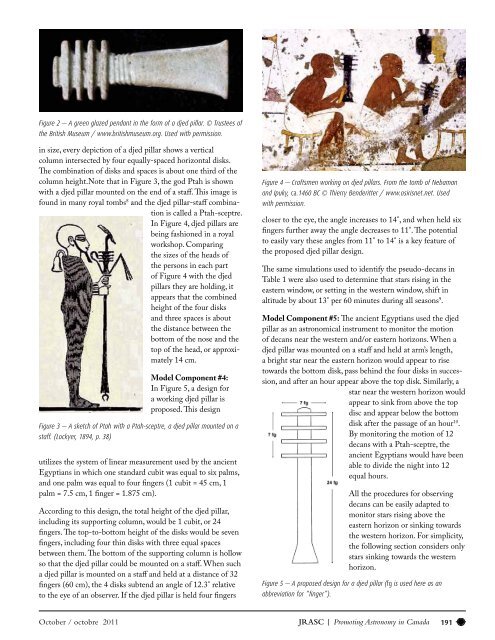The stunning Orion Nebula - The Royal Astronomical Society of ...
The stunning Orion Nebula - The Royal Astronomical Society of ...
The stunning Orion Nebula - The Royal Astronomical Society of ...
You also want an ePaper? Increase the reach of your titles
YUMPU automatically turns print PDFs into web optimized ePapers that Google loves.
Figure 2 — A green glazed pendant in the form <strong>of</strong> a djed pillar. © Trustees <strong>of</strong><br />
the British Museum / www.britishmuseum.org. Used with permission.<br />
in size, every depiction <strong>of</strong> a djed pillar shows a vertical<br />
column intersected by four equally-spaced horizontal disks.<br />
<strong>The</strong> combination <strong>of</strong> disks and spaces is about one third <strong>of</strong> the<br />
column height.Note that in Figure 3, the god Ptah is shown<br />
with a djed pillar mounted on the end <strong>of</strong> a staff. This image is<br />
found in many royal tombs 8 and the djed pillar-staff combination<br />
is called a Ptah-sceptre.<br />
In Figure 4, djed pillars are<br />
being fashioned in a royal<br />
workshop. Comparing<br />
the sizes <strong>of</strong> the heads <strong>of</strong><br />
the persons in each part<br />
<strong>of</strong> Figure 4 with the djed<br />
pillars they are holding, it<br />
appears that the combined<br />
height <strong>of</strong> the four disks<br />
and three spaces is about<br />
the distance between the<br />
bottom <strong>of</strong> the nose and the<br />
top <strong>of</strong> the head, or approximately<br />
14 cm.<br />
Model Component #4:<br />
In Figure 5, a design for<br />
a working djed pillar is<br />
proposed. This design<br />
Figure 3 — A sketch <strong>of</strong> Ptah with a Ptah-sceptre, a djed pillar mounted on a<br />
staff. (Lockyer, 1894, p. 38)<br />
utilizes the system <strong>of</strong> linear measurement used by the ancient<br />
Egyptians in which one standard cubit was equal to six palms,<br />
and one palm was equal to four fingers (1 cubit = 45 cm, 1<br />
palm = 7.5 cm, 1 finger = 1.875 cm).<br />
According to this design, the total height <strong>of</strong> the djed pillar,<br />
including its supporting column, would be 1 cubit, or 24<br />
fingers. <strong>The</strong> top-to-bottom height <strong>of</strong> the disks would be seven<br />
fingers, including four thin disks with three equal spaces<br />
between them. <strong>The</strong> bottom <strong>of</strong> the supporting column is hollow<br />
so that the djed pillar could be mounted on a staff. When such<br />
a djed pillar is mounted on a staff and held at a distance <strong>of</strong> 32<br />
fingers (60 cm), the 4 disks subtend an angle <strong>of</strong> 12.3° relative<br />
to the eye <strong>of</strong> an observer. If the djed pillar is held four fingers<br />
Figure 4 — Craftsmen working on djed pillars. From the tomb <strong>of</strong> Nebaman<br />
and Ipuky, ca.1460 BC © Thierry Benderitter / www.osirisnet.net. Used<br />
with permission.<br />
closer to the eye, the angle increases to 14°, and when held six<br />
fingers further away the angle decreases to 11°. <strong>The</strong> potential<br />
to easily vary these angles from 11° to 14° is a key feature <strong>of</strong><br />
the proposed djed pillar design.<br />
<strong>The</strong> same simulations used to identify the pseudo-decans in<br />
Table 1 were also used to determine that stars rising in the<br />
eastern window, or setting in the western window, shift in<br />
altitude by about 13° per 60 minutes during all seasons 9 .<br />
Model Component #5: <strong>The</strong> ancient Egyptians used the djed<br />
pillar as an astronomical instrument to monitor the motion<br />
<strong>of</strong> decans near the western and/or eastern horizons. When a<br />
djed pillar was mounted on a staff and held at arm’s length,<br />
a bright star near the eastern horizon would appear to rise<br />
towards the bottom disk, pass behind the four disks in succession,<br />
and after an hour appear above the top disk. Similarly, a<br />
star near the western horizon would<br />
appear to sink from above the top<br />
disc and appear below the bottom<br />
disk after the passage <strong>of</strong> an hour 10 .<br />
By monitoring the motion <strong>of</strong> 12<br />
decans with a Ptah-sceptre, the<br />
ancient Egyptians would have been<br />
able to divide the night into 12<br />
equal hours.<br />
All the procedures for observing<br />
decans can be easily adapted to<br />
monitor stars rising above the<br />
eastern horizon or sinking towards<br />
the western horizon. For simplicity,<br />
the following section considers only<br />
stars sinking towards the western<br />
horizon.<br />
Figure 5 — A proposed design for a djed pillar (fg is used here as an<br />
abbreviation for “finger”).<br />
October / octobre 2011 JRASC | Promoting Astronomy in Canada<br />
191

















